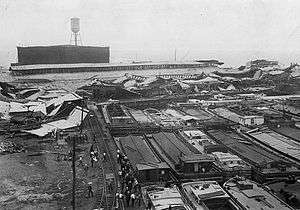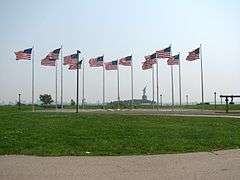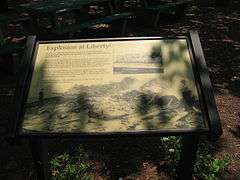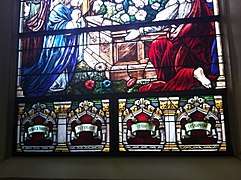Black Tom explosion
The Black Tom explosion was an act of sabotage by German agents to destroy U.S.-made munitions that were to be supplied to the Allies in World War I. The explosions, which occurred on July 30, 1916, in the New York Harbor, destroyed some $20,000,000 worth of military goods.[1][2] This incident, which happened prior to U.S. entry into World War I, also damaged the Statue of Liberty.[3] It was one of the largest artificial non-nuclear explosions to have ever occurred.
| Black Tom explosion | |
|---|---|
.jpg) Black Tom pier shortly after the explosion | |
| Location | Jersey City, New Jersey, U.S. |
| Coordinates | 40°41′32″N 074°03′20″W |
| Date | July 30, 1916 2:08:00 a.m. (EST; GMT−5) |
Attack type | Sabotage, state-sponsored terrorism |
| Deaths | 4 |
| Injured | Hundreds |
| Perpetrators | Imperial German agents |
| Motive | sabotage |
Black Tom Island
The term "Black Tom" originally referred to an island in New York Harbor next to Liberty Island. The island was artificial, created by land fill around a rock of the same name, which had been a local hazard to navigation.[4] By 1880, the island was transformed into a 25-acre (10 ha) promontory,[5] and a causeway and railroad had been built to connect it with the mainland to use as a shipping depot.[6] Between 1905 and 1916, the Lehigh Valley Railroad, which owned the island and causeway, expanded the island with land fill, and the entire area was annexed by Jersey City. A mile-long pier on the island housed a depot and warehouses for the National Dock and Storage Company. Black Tom Island is now part of Liberty State Park.
Black Tom was a major munitions depot for the Northeastern United States. Until early 1915, U.S. munitions companies could sell to any buyer. After the Blockade of Germany by the Royal Navy, however, only the Allied powers could purchase from them. As a result, Imperial Germany sent secret agents to the United States to obstruct the production and delivery of war munitions that were intended to be used by its enemies.[7]
On the night of the attack, about 2,000,000 pounds (910,000 kg) of small arms and artillery ammunition were stored at the depot in freight cars and on barges, including 100,000 pounds (45,000 kg) of TNT on Johnson Barge No. 17.[8] All were waiting to be shipped to Russia.[9] Jersey City's Commissioner of Public Safety, Frank Hague, later said he had been told the barge was "tied up at Black Tom to avoid a twenty-five dollar charge."[10]
Explosion
.jpg)

After midnight on July 30, a series of small fires were discovered on the pier. Some guards fled, fearing an explosion. Others attempted to fight the fires and eventually called the Jersey City Fire Department. At 2:08 am, the first and largest of the explosions took place, the second and smaller explosion occurring around 2:40 am.[11] A notable location for one of the first major explosions was around the Johnson Barge No. 17, which contained 50 tons of TNT and 417 cases of detonating fuses.[12] The explosion created a detonation wave that traveled at 24,000 feet per second with enough force to lift firefighters out of their boots and into the air.[12] Fragments from the explosion traveled long distances, some lodging in the Statue of Liberty and some in the clock tower of The Jersey Journal building in Journal Square, over a mile away, stopping the clock at 2:12 am.[13] The explosion was the equivalent of an earthquake measuring between 5.0 and 5.5 on the Richter scale[10] and was felt as far away as Philadelphia. Windows were broken as far as 25 miles (40 km) away, including thousands in Lower Manhattan. Some window panes in Times Square were shattered. The stained glass windows in St. Patrick's Church were destroyed.[14] The outer wall of Jersey City's City Hall was cracked and the Brooklyn Bridge was shaken. People as far away as Maryland were awakened by what they thought was an earthquake.[15]
Property damage from the attack was estimated at $20,000,000 (equivalent to about $470,000,000 in 2019). On the island, the explosion destroyed more than one hundred railroad cars, thirteen warehouses, and left a 375-foot-by-175-foot crater at the source of the explosion.[11] The damage to the Statue of Liberty was estimated to be $100,000 (equivalent to about $2,350,000 in 2019), and included damage to the skirt and torch.[16]
Immigrants being processed at Ellis Island had to be evacuated to Lower Manhattan. Although one contemporary newspaper report estimated that up to seven[17] people died in the attack, four did definitely die:[18][1] a Jersey City policeman,[19][20] a Lehigh Valley Railroad chief of police,[21][22] a ten-week-old infant,[20] and the barge captain.[20]
Investigation
In the immediate aftermath of the explosion, two watchmen who had lit smudge pots to keep away mosquitoes were questioned by police but the police soon determined that the smudge pots had not caused the fire and that the blast had likely been an accident.[23]
Soon after the explosion, suspicion fell upon Michael Kristoff,[24] a Slovak immigrant.[25] Kristoff would later serve in the United States Army in World War I, but admitted to working for German agents (transporting suitcases) in 1915 and 1916 while the US was still neutral. According to Kristoff, two of the guards at Black Tom were German agents. It is likely that the bombing involved some of the techniques developed by German agents working for German ambassador Count Johann Heinrich von Bernstorff and German Naval Intelligence officer Franz von Rintelen, using the cigar bombs developed by Dr. Walter Scheele.[26] Captain Franz Von Rintelen used many resources at his disposal, including a large amount of money.[23] Captain Franz von Rintelen used these resources to make generous cash bribes, one of which was notably given to Michael Kristoff in exchange for access to the pier.[23] Suspicion at the time fell solely on German saboteurs such as Kurt Jahnke and his assistant Lothar Witzke, who are still judged as legally responsible.[27][28] It is also believed that Michael Kristoff was responsible for planting and initiating the incendiary devices that led to the explosions.[29] Later investigations in the aftermath of the Annie Larsen affair unearthed links between the Ghadar conspiracy and the Black Tom explosion.
Additional investigations by the Directorate of Naval Intelligence also found links to some members of the Irish Clan na Gael group, the Indian Ghadar Party and Communist elements.[30][31] The Irish socialist James Larkin asserted that he had not participated in active sabotage but had encouraged work slowing and strikes for higher wages and better conditions, in an affidavit to McCloy in 1934.[32][33]
The United States did not have an established national intelligence service, other than diplomats and few military and naval attaches,[3] making the investigation difficult. Without a formal intelligence service on the national level, the United States only had rudimentary communications security and no federal statute forbidding peacetime espionage or sabotage,[3] making the connections to the saboteurs and accomplices almost impossible to track.
Aftermath
This attack was one of many during the German sabotage campaign against the United States, and it is notable for its contribution to the shift of public opinion against Germany, which eventually resulted in American support to enter World War I.[3]
The Russian government sued the Lehigh Valley Railroad Company operating the Black Tom Terminal on grounds that lax security (there was no entrance gate; the territory was unlit)[34] permitted the loss of their ammunition and argued that due to the failure to deliver them the manufacturer was obliged by the contract to replace them.[9]
The Lehigh Valley Railroad, advised by John J. McCloy, sought damages against Germany under the Treaty of Berlin from the German-American Mixed Claims Commission. The Mixed Claims Commission declared in 1939 that Imperial Germany had been responsible and awarded $50 million (the largest claim) in damages which Nazi Germany refused to pay.[35] The issue was finally settled in 1953 on $95 million (interest included) with the Federal Republic of Germany.[36] The final payment was made in 1979.[37]
The Statue of Liberty's torch has been closed to the public since the explosion due to structural damages.[38][39] Access was not opened after the 1984–1986 restoration which included repairs to the arm and installation of a new gold-plated copper torch.[40]
Legacy
The Black Tom explosion resulted in the establishment of domestic intelligence agencies for the United States.[41] The then Police Commissioner of New York, Arthur Woods, argued, "The lessons to America are clear as day. We must not again be caught napping with no adequate national intelligence organization. The several federal bureaus should be welded into one and that one should be eternally and comprehensively vigilant." [42] The explosion also played a role in how future presidents responded to military conflict. President Franklin D. Roosevelt used the Black Tom explosion as part of his rationale for the internment of Japanese-Americans following the attack on Pearl Harbor in 1942.[42]
The incident also influenced public safety legislation.[41] As a result of the sabotage techniques used by Germany, and the United States' declaration of war on Germany, led to the creation of the Espionage Act passed by congress in late 1917.[3] Landfill projects later made Black Tom Island part of the mainland, and it was incorporated into Liberty State Park. The former Black Tom Island is at the end of Morris Pesin Drive in the southeastern corner of the park, where a plaque marks the spot of the explosion. A circle of U.S. flags complements the plaque, which stands east of the visitors' center.
The inscription on the plaque reads:
Explosion at Liberty!
On July 30, 1916 the Black Tom munitions depot exploded rocking New York Harbor and sending residents tumbling from their beds.
The noise of the explosion was heard as far away as Maryland and Connecticut. On Ellis Island, terrified immigrants were evacuated by ferry to the Battery. Shrapnel pierced the Statue of Liberty (the arm of the Statue was closed to visitors after this). Property damage was estimated at $20 million. It is not known how many died.
Why the explosion? Was it an accident or planned? According to historians, the Germans sabotaged the Lehigh Valley munitions depot in order to stop deliveries being made to the British who had blockaded the Germans in Europe.
You are walking on a site which saw one of the worse acts of terrorism in American history.
A stained-glass window at Our Lady of Czestochowa Catholic church memorialized the victims of the attack.[43]
- Gallery
 View of the Statue of Liberty from the site of the explosion: The explosion caused $100,000 worth of damage to the statue, and from then onward the torch was off limits to tourists
View of the Statue of Liberty from the site of the explosion: The explosion caused $100,000 worth of damage to the statue, and from then onward the torch was off limits to tourists Commemorative plaque
Commemorative plaque Stained-glass windows from inside Our Lady of Czestochowa Catholic Church in Jersey City, NJ. The bottom stained-glass windows have text in Polish to commemorate the explosion in 1916.
Stained-glass windows from inside Our Lady of Czestochowa Catholic Church in Jersey City, NJ. The bottom stained-glass windows have text in Polish to commemorate the explosion in 1916.- Melted bottle from the Black Tom explosion
See also
References
- "A Byte out of FBI history". Federal Bureau of Investigation. July 30, 2004. Archived from the original on July 15, 2009. Retrieved July 5, 2009.
- Long, John. 2016. "Terrorism's 100th Anniversary". Roanoke Times. July 28, 2016. Page 7.
- The Kaiser Sows Destruction: Protecting the Homeland the First Time Around
- "Providing Better Terminal Facilities for New York". Engineering News Record: 258. July 31, 1880. Retrieved April 26, 2017.
- Roberts, Russell. Rediscover the Hidden New Jersey. New Brunswick, New Jersey: Rutgers University Press, 2015.
- "THE POINT OF ROCKS LINE More about the Little Railroad" (PDF). New York Times. September 8, 1879.
- H. R. Balkhage and A. A. Hahling. The Black Tom Explosion, The American Legion Magazine, August 1964.
- Safety Engineering Vol 32 [1916] Calls this Johnson Barge No.24
- Rielage, Dale C.: Russian Supply Efforts in America During the First World War; McFarland, 2002. (p. 71)
- "Black Tom Explosion (1916)". state.nj.gov. January 26, 2005. Retrieved July 5, 2009.
- Roberts, Sam (July 24, 2016). "An Attack That Turned Out to Be German Terrorism Has a Modest Legacy 100 Years Later". The New York Times. ISSN 0362-4331. Retrieved May 8, 2019.
- "The Black Tom Explosion". www.firerescuemagazine.com. Retrieved May 9, 2019.
- "Looking Back - Black Tom railroad yard - NFPA Journal". www.nfpa.org. Retrieved February 26, 2019.
- Capo, Fran (2004). "Terrorist Attack Blamed on Mosquitoes". It happened in New Jersey. Guilford, Conn.: Twodot. p. 106. ISBN 0-7627-2358-0.
- Nash, Margo (September 23, 2001). "ON THE MAP; Explosion by the Hudson, Foreign Espionage, Local Fear: 1916". The New York Times.
- Frank Warner (July 4, 2009). "When Liberty trembled". The Morning Call. Retrieved July 4, 2009.
- "Eugene Register-Guard – Google News Archive Search". news.google.com.
- "Rogue River courier. (Grants Pass, Or.) 19??-1918, August 01, 1916, DAILY EDITION, Image 2". August 1, 1916. pp. PAGE TWO – via chroniclingamerica.loc.gov.
- "The Officer Down Memorial Page Remembers". The Officer Down Memorial Page. 2009. Retrieved July 5, 2009.
- Carmela Karnoutsos (2009). "Black Tom Explosion". New Jersey City University. Archived from the original on December 5, 2010. Retrieved July 5, 2009.
- "The Officer Down Memorial Page Remembers". The Officer Down Memorial Page. 2009. Retrieved July 5, 2009.
- "Safety Engineering". A. H. Best. Company. July 25, 2017 – via Google Books.
- King, Gilbert. "Sabotage in New York Harbor". Smithsonian. Retrieved January 22, 2018.
- "World War I Intrigue: German Spies in New York!". February 27, 2013.
- Carmela Karnoutsos. Black Tom Explosion Archived December 5, 2010, at the Wayback Machine, New Jersey State University
- H. R. Balkhage and A. A. Hahling (August 1964). "The Black Tom Explosion". The American Legion Magazine. Retrieved July 5, 2009.
- Witcover, Jules. Sabotage at Black Tom: Imperial Germany's Secret War in America, 1914–1917. Chapel Hill, N.C.: Algonquin Books of Chapel Hill, 1989.
- World War I Encyclopedia. Volume 4 S–Z. Edited by Spencer Tucker, p. 1033.
- King, Gilbert. "Sabotage in New York Harbor". Smithsonian. Retrieved May 9, 2019.
- Stafford, D. "Men of Secrets: Teddy Roosevelt and Winston Churchill". New York Times. Retrieved October 24, 2007.
- Moynihan, D.P. "Report of the Commission on Protecting and Reducing Government Secrecy. Senate Document 105-2". Fas.org. Retrieved October 24, 2007.
- Millman, C. The Detonators: The Secret Plot to Destroy America and an Epic Hunt for Justice (New York: Little, Brown, 2006) ISBN 978-0-316-73496-7.
- Review of Millman's book in The New York Observer, July 16, 2006. Archived January 23, 2011, at the Wayback Machine
- Landau, Henry, Capt. The Enemy Within: The Inside Story of German Sabotage in America. New York: Putnam, 1937, p. 78-80.
- Sabotage in New York Harbor, Smithsonian.com
- Michael Warner. Protecting the Homeland the First Time Around: The Kaiser Sows Destruction, Studies in Intelligence, Vol 46, No 1.
- Burkhard Jähnicke. Washington und Berlin zwischen den Kriegen: Die Mixed Claims Commission in den transatlantischen Beziehungen. Baden-Baden: Nomos, 2003, p. 240. ISBN 9783832900564
- "Frequently Asked Questions – Statue Of Liberty National Monument (U.S. National Park Service)". www.nps.gov.
- Long, John. 2016. "Terrorism's 100th Anniversary", Roanoke Times, July 28, 2016, p. 7.
- Nina Ruggiero. Why can't we go up the Statue of Liberty's torch? amNewYork, October 28, 2016.
- Sabella, Elke Weesjes. "100 Years of Terror". hazards.colorado.edu. Retrieved May 9, 2019.
- Engel, Charles; Rogers, John (July 1999). "Violating the Law of One Price: Should We Make a Federal Case Out of It?". Cambridge, MA. doi:10.3386/w7242. Cite journal requires
|journal=(help) - Pyle, Richard (July 30, 2006). "1916 Black Tom Blast Anniversary Observed". The Washington Post. Retrieved February 1, 2011.
Bibliography
- Chad Millman (July 12, 2006). The Detonators: The Secret Plot to Destroy America and an Epic Hunt for Justice (July 12, 2006 ed.). Little, Brown and Company. p. 352. ISBN 0-316-73496-9.
- Jules Witcover (1989). Sabotage at Black Tom: Imperial Germany's Secret in America, 1914–1917 (May 1989 ed.). Algonquin Books; First Edition/First Printing edition. p. 339. ISBN 0-912697-98-9.
- Ron Semple, Black Tom: Terror on the Hudson (October 30, 2015) Top Hat Books, p. 514. ISBN 978-1-78535-110-5
External links
| Wikimedia Commons has media related to Black Tom explosion. |
- Black Tom Explosion (1916), Liberty State Park
- Sabotage in New York Harbor, Smithsonian.com
- The Black Tom Explosion, History.com
- GenDisasters Black Tom 1916